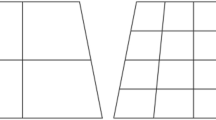Abstract
This paper presents a new, fast and economical method for digitizing a rock surface profile to determine its joint roughness coefficient (JRC) value (Barton and Choubey, Rock Mech Rock Eng 10:1–54, 1977) using a set of existing parameters, the appropriateness of which has been tested. The new procedure was applied to four rock road cuts in the Alpujarra area of Granada province (Andalusia, Spain), supported by 117 digitized profiles. The method avoids any personal subjectivity bias. The usual subjectivity in the visualization and assessment of the JRC value is estimated here by a survey test answered by 90 trained users. The survey test consisted of a set of JRC visual comparisons of 12 roughness profiles, selected from the 117 profiles surveyed during the field research in the Alpujarra region, with the Barton typical profiles. The results of the survey clearly show systematic inaccuracies in the traditional procedure that are reduced if the advice presented in the conclusions of this paper is taken in account when performing the visual estimation.
















Similar content being viewed by others
Abbreviations
- B&W:
-
Black and white
- C :
-
Roughness parameter characterizing the distribution of inclinations over a profile
- D :
-
Fractal dimension
- ICCP:
-
Civil engineering degree
- JRC:
-
Joint roughness coefficient
- JRC0 :
-
Value of JRC obtained by mechanical tests by Barton and Choubey (1977)
- JRC1 :
-
Value of JRC obtained by applying an algorithm to a vector
- JRC2 :
-
Value of JRC obtained by applying the new method to a mold built from a vector
- L θ* :
-
Normalized length of the fraction of the profile with a higher inclination than a threshold value
- .pbm:
-
Portable bitmap format
- R P :
-
Roughness profile index
- UGR:
-
University of Granada (Spain)
- y :
-
Roughness profile vector
- Z 2 :
-
First-derivative root-mean-square
- Δs :
-
Spatial sampling interval
- θ*:
-
Inclination of a fraction of the profile along the shear direction
- θ*max :
-
Maximum inclination of the profile along the shear direction
References
Aldaya F, García Dueñas V, Navarro-Vilá F (1979) Los Mantos Alpujárrides del tercio central de las Cordilleras Beticas. Ensayo de correlación tectónica de los Alpujárrides. Acta Geológica Hispánica 14:154–166
Asadollahi P, Tonon F (2010) Constitutive model for rock fractures: revisiting Barton’s empirical model. Eng Geol 113(1–4):11–32
Asadollahi P, Invernizzi MA, Addotto S, Tonon F (2010) Experimental validation of modified Barton’s model for rock fractures. Rock Mech Rock Eng 43(5):597–613
Barton N, Choubey V (1977) The shear strength of rock joints in theory and practice. Rock Mech Rock Eng 10:1–54
Beer AJ, Stead D, Coggan JS (2002) Technical note estimation of the joint roughness coefficient (JRC) by visual comparison. Rock Mech Rock Eng 35:65–74
Du S, Hu Y, Hu X (2009) Measurement of joint roughness coefficient by using profilograph and roughness ruler. J Earth Sci 20(5):890–896
Grasselli G, Egger P (2003) Constitutive law for the shear strength of rock joints based on three-dimensional surface parameters. Int J Rock Mech Min Sci 40(1):25–40
Harrison JP (2008) Contributions to Géotechnique 1948–2008: engineering geology rock mechanics and rock engineering. Géotechnique 58(5):449–555
Hencher SR (2012) Discussion of Alejano, Gonzalez and Muralha (2012). Rock Mech Rock Eng 45(6):1137–1139
Hsiung SM, Ghosh A, Ahola MP, Chowdhury AH (1993) Assessment of conventional methodologies for joint roughness coefficient determination. Int J Rock Mech Min Sci Geomech Abstr 30(7):825–829
ISRM (1978) International society for rock mechanics commission on standardization of laboratory and field tests: suggested methods for the quantitative description of discontinuities in rock masses. Int J Rock Mech Min Sci Geomech Abst 15(6):319–368
Lee YH, Carr JR, Barr DJ, Hass CJ (1990) The fractal dimension as a measure of the roughness of rock discontinuity profiles. Int J Rock Mech Min Sci Geomech Abst 27(6):453–464
Maerz NH, Franklin JA, Bennett CP (1990) Joint roughness measurement using shadow profilometry. Int J Rock Mech Min Sci Geomech Abstr 27(5):329–343
Mandelbrot BB (1977) Fractals: form, chance and dimension. Freeman, San Francisco
Rafek AG, Goh TL (2012) Correlation of joint roughness coefficient (JRC) and peak friction angles of discontinuities of Malaysian schists. Earth Sci Res 1(1):57–63
Ribeiro RP, Paraguassú AB, Rodrigues JE (2007) Sawing of blocks of siliceous dimension stone: influence of texture and mineralogy. Bull Eng Geol Environ 66(1):101–107
Ross-Brown DM, Walton G (1975) A portable shear box for testing rock joints. Int J Rock Mech Min Sci Geomech Abstr 7(3):129–153
Stimpson B (1982) A rapid field method for recording joint roughness profiles. Int J Rock Mech Min Sci Geomech Abstr 19(6):345–346
Tatone BSA, Grasselli G (2009) A method to evaluate the 3D roughness of fracture surface in brittle geo-materials. Rev Sci Instrum 80(125):1–10. doi:10.1063/1.3266964
Tatone BSA, Grasselli G (2010) A new 2D discontinuity roughness parameter and its correlation with JRC. Int J Rock Mech Min Sci 47(8):1391–1400
Tatone BSA, Grasselli G (2012) Quantitative measurements of fracture aperture and directional roughness from rock cores. Rock Mech Rock Eng 45(4):619–629
Tse R, Cruden DM (1979) Estimating joint roughness coefficients. Int J Rock Mech Min Sci Geomech Abstr 16(5):303–307
Xia CC, Tang ZC, Xiao WM, Song YL (2013) New peak shear strength criterion of rock joints based on quantified surface description. Rock Mech Rock Eng. doi:10.1007/s00603-013-0395-6
Yu X, Vayssade B (1991) Joint profiles and their roughness parameters. Int J Rock Mech Min Sci Geomech Abstr 28(4):333–336
Acknowledgments
This research was supported by projects CGL2008-04854 funded by the Ministry of Science and Education of Spain. It was developed in the RNM-121 Research Group funded by the Andalusian (Spain) Research Plan.
Author information
Authors and Affiliations
Corresponding author
Rights and permissions
About this article
Cite this article
Alameda-Hernández, P., Jiménez-Perálvarez, J., Palenzuela, J.A. et al. Improvement of the JRC Calculation Using Different Parameters Obtained Through a New Survey Method Applied to Rock Discontinuities. Rock Mech Rock Eng 47, 2047–2060 (2014). https://doi.org/10.1007/s00603-013-0532-2
Received:
Accepted:
Published:
Issue Date:
DOI: https://doi.org/10.1007/s00603-013-0532-2




